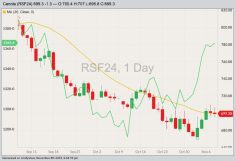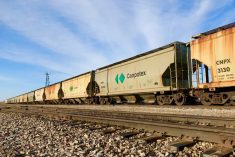Having cut speed limits for trains hauling dangerous goods following a fiery derailment earlier this month, federal Transport Minister Marc Garneau is adjusting those limits for a “more targeted” approach.
Garneau announced Sunday he has pulled his Feb. 6 ministerial order on speed limits and replaced it with a new one affecting so-called “key trains” — that is, trains carrying either 20 or more cars of dangerous goods or one or more cars of gases that are toxic when inhaled.
Read Also

Senft to step down as CEO of Seeds Canada
Barry Senft, the founding CEO of the five-year-old Seeds Canada organization is stepping down as of January 2026.
The new limits took effect “immediately” on Sunday and are in place until April 1, he said. Dangerous goods include flammables, explosives, compressed or liquefied gases, toxic substances, corrosives and radioactive materials, among others.
The speed limit for key trains will now be 35 miles per hour (56 km/h) in metropolitan areas, Garneau said. Outside of metropolitan areas where there are no track signals, the speed is limited to 40 mph (64 km/h).
The new order also sets separate limits for “higher risk” key trains, defined as unit trains where tank cars are loaded with a single dangerous-goods commodity moving to the same point of destination; or trains that include any combination of 80 or more tank cars containing dangerous goods.
For higher risk key trains, the new speed limit is 25 mph (40 km/h) where there are no track signals. In metropolitan areas, the speed limit for those trains is 30 mph (48 km/h) — unless the metropolitan area is in a “non-signal” territory, where the speed limit will remain 25 mph “for greater certainty.”
Meanwhile, Transport Canada is working with the railways on “a more comprehensive set of safety measures, which will include permanent measures,” the government said in a release.
Those measures are to be aimed at track infrastructure maintenance and renewal, winter operations, safety practices and “any other actions necessary to keep Canadians safe.”
The tighter speed limits follow “a number of recent derailments of trains transporting dangerous goods which have resulted in the breach of tank cars and the release of dangerous goods,” Garneau said in Sunday’s order.
The listed examples included a derailment that spilled crude oil near St. Lazare in western Manitoba last February, a derailment and fire near Guernsey, Sask. in December and a second derailment in the same area near Guernsey, about 40 km south of Humboldt, earlier this month.
Affected rail companies have until March 17 to file written requests for a review of Garneau’s order if they so wish. — Glacier FarmMedia Network
















